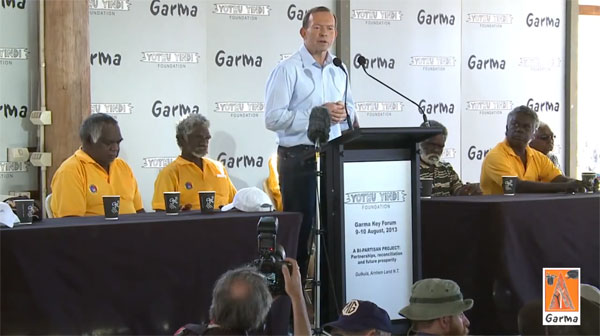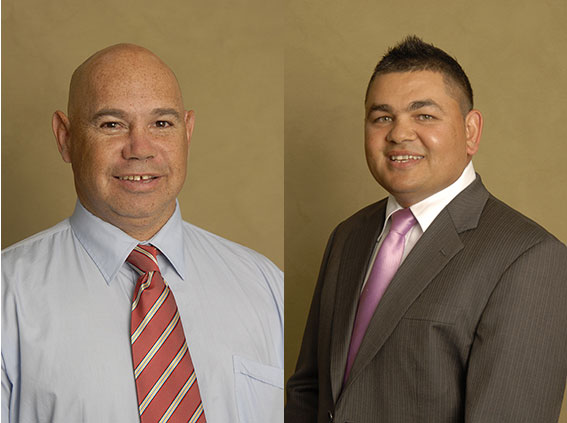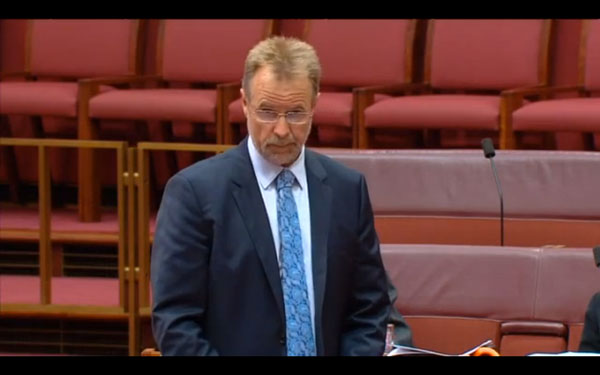It was a promise delivered in a rare, unscripted moment at the heady start of the 2013 federal election campaign.
Opposition leader Tony Abbott was at the podium in the heat of the annual Garma Festival.
If he made it to the Lodge, he pledged, he would become a “Prime Minister for Aboriginal Affairs… the first I imagine that we have ever had.”
Abbott ploughed on, buoyed by the buzz from the increasingly conservative mob which gathers for Garma these days.
He’d spend one week each year in “an Indigenous place”.
This would allow him to “sit down with people and talk with them in their country.”
Then came the promise in an open question to his host, Galarrwuy Yunupingu.
“Why shouldn’t I, if you will permit me, spend my first week as Prime Minister, should that happen, on your country?”
“I know there will be people who say ‘now as Prime Minister you can’t do that, you are goofing off, you’re not doing your job….
“But the fact is these places are home to the First Australians, why shouldn’t they be home, even if only for a few days, to the Prime Minister of our country.”
Abbott, of course, broke the promise.
He spent his first week as Prime Minister at the other end of the country, in Canberra.
He was also a no-show at this year’s Garma Festival.
Yunupingu made a public point of noting Abbott’s absence at the main Garma forum in the first week of August.
Abbott issued a statement which said he’d fulfill his commitment in a “few weeks time”.
That was a few weeks ago
But, one wonders why. What can Abbott, and the inevitable trailing plane loads of advisors and bureaucrats, possibly learn about land rights from a week-long taxpayer funded visit to Yunupingu’s home communities now, that they do not already know?

It’s not as though Yunupingu, and his advisors, are strangers in Abbott’s camp or that of his NT-based Aboriginal Affairs Minister, Senator Nigel Scullion.
The self-anointed Prime Minister for Aboriginal Australia could do thousands of Aboriginal men, women and children a power of good by ditching another taxpayer-funded junket to the picturesque backdrops of Ski Beach.
He should instead take a long, hard, sobering look his own backyard.
There are more than 60 discrete Aboriginal communities in Abbott’s home state of New South Wales.
They are home to the poorest and sickest people in the state.
We are talking about more than 6,500 men women and children condemned to live in daily squalor.
They occupy more than 2,500, often dilapidated, properties.
The most rudimentary services required for a healthy life are woefully inadequate or simply not there.
Poverty, neglect and stagnation are endemic.
We are talking about the basic services for good health taken for granted by all other Australians. And the occupants are caught in a cruel and curious political limbo.
These communities are all former reserves and ex-missions.
They were transferred from the Crown into the ownership of impoverished start up Local Aboriginal Land Councils with the proclamation of the Aboriginal Land Rights Act in 1983.
The Act determines that all Aboriginal land is private land. All infrastructure which is installed on that land is private.
The responsibility for its provision, and maintenance, rests with the landholder. (the LALC).
This includes water and sewerage, stormwater and drainage, roads and road safety, kerbing, guttering and footpaths, street lighting, emergency management, community facilities, telecommunications, power, garbage and waste removal.
It was a great government flick pass.
The Act never made provision for any investment in, and maintenance of, community infrastructure back in 1983, despite the fact the housing and infrastructure was in poor condition at the time.
No dedicated provision has been made since.
Cash poor LALCs cannot afford to meet demand. Governments and Aboriginal leaders ignore it.
The overriding tragedy is that these living conditions can be fixed.
There is a successful and well-established model for courageous Government and Aboriginal leaders to follow.
The only thing missing is political will.
A confidential consultancy report on addressing these unmet needs was produced for the NSW Aboriginal Housing Office in NSW, back in May 2012.
The report, by Robyn Kennedy Consultants, estimated an investment of $200 million was required to bring the communities into the 21st century.
This included capital costs of $97 million to bring the infrastructure up to speed.
An estimated $103 million in ongoing maintenance costs — or about $5.2 million a year — is required over 20 years.
The Kennedy Report proposed funding be shared between the Commonwealth and New South Wales Governments, and the self-funded peak body, the NSW Aboriginal Land Council, which sits on cash assets of more than $600 million.
That money generates up to $50 million a year in interest income.
The Kennedy Report recommended a tri-partite agreement based on the successful Aboriginal Communities Water and Sewerage Program.
This programme has successfully targeted the appalling water and sewerage services in the discrete communities.
It was established in July 2008 with a 50-50 funding commitment of more than $200 million over 25 years in recurrent funding from the former NSW Labor Government and the New South Wales Aboriginal Land Council, led at the time by Chairwoman Bev Manton.
Her courageous political leadership ensured the Council backed the programme by putting its money where its mouth was.
She did so in the face of strong advice from some of her bureaucrats that NSWALC should reject the 50:50 funding offer and argue the provision of decent drinking water and sewerage services was the sole responsibility of government.
Thanks to this award-winning project, which continues under the current NSW Liberal-National Government, more than 4,000 people on the communities are no longer living with antiquated, health sapping, water and sewerage services.
They now enjoy drinking water to the same – if not higher – standard than their fellow Australians.
Now you’d think the peak body would be pressing the Commonwealth and NSW Governments for a similar funding agreement to cover all the other basic services.
Think again.
It is now attempting its own flick pass.
The Craig Cromelin-led NSW Aboriginal Land Council is now actively seeking to offload its financial and political commitment to the successful water and sewerage programme ($1.5-$2 million in 2014-15) to the Commonwealth Government.
It also wants the Commonwealth to pick up the NSWALC’s financial obligation to a subdivision project (expected $3 million in 2014-15) on a small number of ex-reserves and missions, which it currently joint funds with the Commonwealth.
This will be news to the land council network, and to Ms Manton.
This “strategy” is confirmed in copies of briefing notes provided to the current NSWALC Chairperson, Craig Cromelin, his deputy Roy Ah See, and the Council’s Chief Executive Officer, Les Turner ahead of a meeting with Senator Scullion in March this year.

The notes were prepared by the same bureaucrats who originally advised Manton to reject the then NSW Labor Government’s offer of $100 million for a 50:50 funding deal on water and sewerage.
The notes for the Scullion meeting describe the award winning water and sewerage project as a “forced joint venture”.
They proposed the trio tell Scullion the NSWALC’s financial commitment to schemes such as these have pushed the NSWALC “off the mark” from core business, causing it “serious budgetary stress,” from which it requires “financial relief”.
They proposed Cromelin, Ah See and Turner advise Scullion the NSWALC has over-committed itself in funding priorities and services normally provided by Government.
These commitments had “distracted” NSWALC from its statutory obligations to promote land rights; effectively manage land under its control, and “provide community benefits that complement and enhance the mainstream services that should be provided by the three tiers of government.”
The trio are advised to ask Scullion to consider “relieving” NSWALC of its expected contribution of $3 million to the subdivision project, with the Commonwealth “absorbing this cost itself,” and ask the Commonwealth to take over the NSWALC’s annual contributions to the water and sewerage program.
They also advise Scullion be asked to kick in a matching contribution to the key “initiative” of the Cromelin/Ah See Council… a commitment of $16 million over the next five years on vague plans to stimulate economic development.

The trio accepted the advice, and the attempted flick pass is confirmed in the letter to Scullion from Cromelin in mid-March.
The Cromelin Council has already allocated monies in its current budget to stimulate business development “throughout the Aboriginal land council network in NSW”.
They want to shoot for the economic stars, while more than 6,000 of their constituents live in the dirt.
A couple of dedicated NSWALC officers have worked tirelessly in recent years to prepare a case for the funding of unmet need in infrastructure.
It was recently presented to Scullion at a meeting of the Cromelin Council.
But it contains no suggestion of any financial commitment to any joint funding from NSWALC.
The case has been well supported by Commonwealth bureaucrats, particularly those working in Aboriginal Affairs and Health.
They scratch their heads while their political masters, Aboriginal and mainstream, seek to opt out or twiddle their thumbs.
They wonder why the big fix on water and sewerage and the massive fail on fixing the environmental health problems which plague the communities in unmet need on essential services.
This is especially so given the absence or lack of maintenance of these services is a direct result of the provision of land rights in the first place.
They also ask how the NSWALC can possibly expect the NSW and Commonwealth Governments to show any real interest in unmet need if it is not prepared to have any of its own skin in the game.
This, in part, explains why Abbott can pencil in yet another trip to Arnhem Land without worrying about any political turbulence from elected Aboriginal leaders or Liberal/National colleagues in his home state.
Abbott, who also wants to be seen as the Prime Minister for Infrastructure, has never uttered a public word about the lack of basic services in NSW Aboriginal communities. He’s rarely, if ever, visited any of the 60-plus communities.
His public silence is matched by the Baird Government and its junior Aboriginal Affairs Minister in NSW, Victor Dominello.
Dominello actively backs the economic development pipedreams of Cromelin, Ah See and their seven fellow Councillors, but he’s not looking at committing any taxpayer funds to that exercise.
He’s also had little to say in public about the dire unmet need in the discrete Aboriginal communities across the State.
Scullion is still considering the NSWALC pitch, but New Matilda is informed he’s unlikely to support it.
In any case NSWALC might already have its answer.
The Commonwealth has just released the infrastructure funding guidelines under its Indigenous Advancement Strategy.
It only funds unmet need in infrastructure in Aboriginal communities it deems “remote”.
It had drawn arbitrary lines on a map declaring a tiny portion of Aboriginal communities in NSW as “remote”.
Those guidelines clearly retain that tiny portion of NSW in the “remote” category.
Any communities outside this tiny area do not meet the funding guidelines.
The COAG Reform Council’s report on Indigenous Reform and Performance clearly shows Aboriginal people everywhere are deeply disadvantaged.
There are massive gaps in socio-economic outcomes for the 80 per cent of Aboriginal people living in non-remote Australia who cannot gain equitable access to mainstream services.
The Kennedy Report put that up in lights for NSW, and built on costing studies dating back to 2009.
The need is undeniable
A trip to the back of Bourke might not yield Abbott and his entourage the exotic media coverage they no doubt count upon in Arnhem Land. But such a trip might just give needy Aboriginal constituents in his home state the much needed voice they have not got… and some renewed hope for improvement in their living conditions.
As it stands, they have neither.
Those elected, and paid handsomely to represent them, should be calling on him to forget the VIP flight to Darwin and get back on his bike.
Ironically, the region with the greatest call on the water and sewerage project – and the greatest call on money to fix up unmet need – is in Chairperson Cromelin’s backyard.
Cromelin should stop backpedalling and put Aboriginal compensation monies where his mouth is.
*Brian Johnstone is a freelance journalist. He worked for 11 years as a senior media and political strategist for the NSWALC. He wrote the decision paper for Council advocating its commit to the Aboriginal Communities Water and Sewerage programme.
Donate To New Matilda
New Matilda is a small, independent media outlet. We survive through reader contributions, and never losing a lawsuit. If you got something from this article, giving something back helps us to continue speaking truth to power. Every little bit counts.



